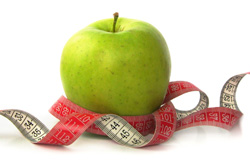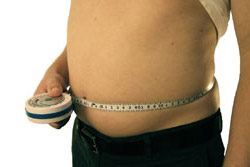Assessing Central Obesity: Waist to Hip Ratio
 Introduction to the waist to hip ratio
Introduction to the waist to hip ratio- Central obesity/abdominal fat mass
- How does the waist to hip ratio compare to other obesity measurements?
- Measuring the waist to hip ratio
- Waist to hip ratio cut-off levels
- Importance of reliable and accurate measurement of the waist to hip ratio
- Limitations of the waist to hip ratio
Introduction to the waist to hip ratio
The waist to hip ratio (WHR) is a simple measure of central obesity. The score from the WHR predicts the risk of developing several conditions associated with excess abdominal fat. All you need to measure your WHR is a measuring tape. You can ask your doctor to do it for you to make sure you have made the right measurements. Your doctor will also perform the standard measurement of overweight and obesity, the body mass index (BMI).
Central obesity/abdominal fat mass
There are three forms of obesity: peripheral, central or a combination of both. Peripheral obesity is the accumulation of excess fat in the buttocks, hips and thighs, whereas central obesity is an excess accumulation of fat in the abdominal area. This is an especially dangerous place for fat to build up because it is closely located to the vital organs and their blood supply. The fat can then be released into the blood; this process is responsible for most of the negative health consequences associated with obesity, such as:
- Type 2 diabetes;
- Glucose intolerance;
- High blood pressure;
- Endometrial cancer;
- Artherosclerosis;
- Insulin resistance;
- Altered metabolic profile;
- Metabolic syndrome;
- Cardiovascular disease;
- Obesity-related lipid disorders (e.g. hypertriglyceridaemia; hypo-HDL-cholesterolaemia).
Central obesity is very common in elderly people because body fat is often redistributed to the abdominal region during the ageing process. On average, premenopausal women have half the abdominal fat of men; this is largely due to body shape. While women generally have a higher total and percentage body fat, it is more often located on their hips and thighs due to their pear-shaped bodies. Men naturally have an apple shape, and carry excess weight in their abdominal region.
How does the waist to hip ratio compare to other obesity measurements?
The standard measurement of overweight and obesity is the body mass index (BMI). The BMI is calculated using body mass and height, and the resulting score is an indirect measure of body fat.
This information will be collected for educational purposes, however it will remain anonymous.
Alone, BMI is not enough to determine the risk of developing obesity-related conditions. Excess abdominal fat, regardless of overall body fat, will predispose you to obesity-related disease. This highlights the importance of measuring WHR. BMI remains the best indication of underweight and WHR should not be used for this measure.
Two people with very similar BMIs may vary substantially in the proportion of abdominal fat. Accordingly, a person with a BMI in the “normal” weight range may exceed the safe range of abdominal fat. A prime example of this is in older individuals. As lean muscle mass declines their BMI may not change, or may even decrease, but fat levels could be increasing with the accompanying redistribution of body fat.
WHR is not the only measure of abdominal obesity. Assessing waist circumference (WC) is also very useful, and sometimes more reliable. Both the WC and the WHR have their individual strengths and weaknesses and both are usually measured in a clinical evaluation.
 | For more information, seeBody Mass Index and Measuring Central Obesity: Waist Circumference. |
Measuring the waist to hip ratio
 WHR is calculated by dividing waist circumference by hip circumference.
WHR is calculated by dividing waist circumference by hip circumference.
Waist measurements
Waist measurements should be taken as you breathe out. You should relax and not contract any abdominal muscles. The tape measure should be aligned at the level of the belly button, and circle the whole way around the body and back to the starting point.
Hip measurement
The hip measurement is taken as the largest circumference around the buttocks.
Waist to hip ratio cut-off levels
Excess abdominal fat distribution is indicated by a WHR greater than 0.8 for women and 0.9 for men.
Due to the natural variation in body shape and composition between different ethnicities, the cut-off points for determining central obesity are slightly different. Ethnicities with a smaller build, such as Japanese and Chinese, may be at risk at a lower WHR. It is best to see your doctor to have a thorough examination that takes these factors into account.
If your WHR is greater than the cut-off levels, you should see a doctor. You are at risk for developing the following conditions:
- Diabetes: A high WHR is not the most reliable prediction of diabetes, but it does correlate with individuals who have diabetic levels of fasting blood glucose. A WHR over 0.96 for men and 0.83 for females is associated with an increased risk of developing diabetes. If these WHR values are coupled with a BMI over 25, the risk is even greater. Tests for diabetes should be carried out immediately, and at least every three years.
- Ischaemic stroke: An elevated WHR is associated with an increased risk of ischaemic stroke. A 1.6-fold greater risk has been determined for females with a WHR greater than 0.87, and a 2.3-fold greater risk for men with a WHR greater than 0.98.
- High blood pressure: A large WHR is associated with high blood pressure. Even if you have a BMI in the normal range, you will still have an increased risk of hypertension if your WHR is high.
- Reduced lung function: Poor lung function is significantly correlated to a WHR greater than 0.94±0.06. Reduced lung function causes difficulties in breathing and physical performance.
- Metabolic risk factors: A large WHR is associated with abnormal levels of uric acid, C-reactive protein, triglyerol, insulin, glucose and HDL cholesterol. These organic compounds are all associated with various medical conditions.
Importance of reliable and accurate measurement of the waist to hip ratio
 Make sure you are measuring yourself correctly. A simple measurement error could lead to an incorrect WHR. If you underestimate your WHR, you may incorrectly think that you are not at risk for a number of conditions and diseases. You should see your doctor for an evaluation if you think you carry excess weight in your abdominal region.
Make sure you are measuring yourself correctly. A simple measurement error could lead to an incorrect WHR. If you underestimate your WHR, you may incorrectly think that you are not at risk for a number of conditions and diseases. You should see your doctor for an evaluation if you think you carry excess weight in your abdominal region.
Limitations of the waist to hip ratio
Hip circumference and waist circumference are each related to different biological mechanisms. Waist circumference measures abdominal and intra-abdominal fat. Hip circumference measures a different set of body components, such as muscle and bone mass, as well as fat. An individual may have a dangerous level of abdominal fat, but the WHR may be hard to determine if the hip circumference is especially large.
Pear-shaped women carry weight mainly on their hips and thighs. They may still have a large at-risk waist circumference, but their ratio may not correctly identify central obesity. This highlights the importance of assessing WC alone as well as in WHR.
More information
 | For more information on nutrition, including information on types and composition of food, nutrition and people, conditions related to nutrition, and diets and recipes, as well as some useful videos and tools, see Nutrition. |
 | For more information on obesity, health and social issues, and methods of weight loss, as well as some useful tools, see Weight Loss. |
References
- Lee K, Song YM, Sung J. Which obesity indicators are better predictors of metabolic risk?: Healthy Twin Study. Obesity (Silver Spring). 2008;16(4):834-40. [Abstract | Full text]
- Feldstein CA, Akopian M, Olivieri AO, et al. A comparison of body mass index and waist-to-hip ratio as indicators of hypertension risk in an urban Argentine population: A hospital-based study. Nutr Metab Cardiovasc Dis. 2005:15(4):310-5. [Abstract]
- McArdle WD, Katch FI, Katch VL. Exercise Physiology: Energy, Nutrition, and Human Performance (5th edition). Baltimore: Lippincott Williams & Wilkins; 2001. [Book]
- Wahlqvist ML. Australia and New Zealand: Food and Nutrition (2nd edition). Crows Nest: Allen and Unwin; 2002. [Book]
- Wu CH, Heshka S, Wang J, et al. Truncal fat in relation to total body fat: Influences of age, sex, ethnicity and fatness. Int J Obes (Lond). 2007;31(9):1384-91. [Abstract | Full text]
- Suk SH, Sacco RL, Boden-Albala B, et al. Abdominal obesity and risk of ischemic stroke: The Northern Manhattan Stroke Study. Stroke. 2003;34(7):1586-92. [Abstract | Full text]
- Panoulas VF, Ahmad N, Fazal AA, et al. The inter-operator variability in measuring waist circumference and its potential impact on the diagnosis of the metabolic syndrome. Postgrad Med J. 2008;84(993):344-7. [Abstract]
- Tovée MJ, Benson PJ, Emery JL, et al. Measurement of body size and shape perception in eating-disordered and control observers using body-shape software. Br J Psychol. 2003;94(Pt 4):501-16. [Abstract]
- Diaz VA, Mainous AG 3rd, Baker R, et al. How does ethnicity affect the association between obesity and diabetes? Diabet Med. 2007;24(11):1199-204. [Abstract]
- Balkau B, Sapinho D, Petrella A, Mhamdi L, Cailleau M, Arondel D, et al. Prescreening tools for diabetes and obesity-associated dyslipidaemia: Comparing BMI, waist and waist hip ratio. The D.E.S.I.R. Study. Eur J Clin Nutr. 2006;60(3):295-304. [Abstract | Full text]
- Wannamethee SG, Shaper AG, Whincup PH. Body fat distribution, body composition, and respiratory function in elderly men. Am J Clin Nutr. 2005;82(5):996-1003. [Abstract | Full text]
- Bigaard J, Frederiksen K, Tjønneland A, et al. Waist and hip circumferences and all-cause mortality: Usefulness of the waist-to-hip ratio? Int J Obes Relat Metab Disord. 2004;28(6):741-7. [Abstract | Full text]
Dates
Tags
Created by:

 Login
Login














